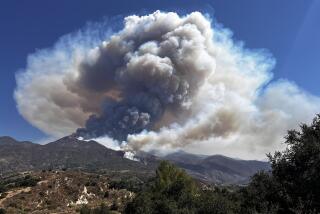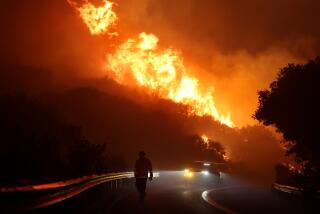Restrict building in high-risk areas?
Today’s topic: The fires near Los Angeles have destroyed or threatened homes in areas where the risk of a devastating blaze has long been known to be high. Should government do more to discourage building in wildlife-urban interfaces, or are there better means of protecting homes in fire-prone areas?
Let free markets guide fire protection services
Point: Adam B. Summers
Bill,
While the risk of wildfire damage to people and property is greater in wildlife-urban interfaces, heavy-handed government restrictions on where people live and how their homes are built are not the solutions to minimizing destruction. I agree with the sentiment from your Wednesday post that homeowners must be accountable for wildfire prevention and protection efforts on their own property. With private property rights come private responsibilities, including the responsibility, if one truly values his or her home and investment, to try to protect that property. It is not fair to taxpayers across the state to have to subsidize fire protection for such a relatively small percentage of the population that lives in high-risk areas and consumes a disproportionate amount of wildfire protection resources.
It does not help, however, that a sense of responsibility has been eroded by increased dependence on government. The more people look to the government to provide for all their wants and needs, the more they abdicate their own responsibilities.
A large part of the reason that so many resources are dedicated to protecting homes in high-risk areas is that the fire insurance market in California has been distorted. The problem is that the state’s creation of an insurer of last resort in the form of the Fair Access to Insurance Requirements (FAIR) Plan has effectively subsidized those who build or purchase homes in fire-prone areas. As I noted in Thursday’s exchange, this shields home-buyers from the true costs of insuring homes in fire-prone areas, and thus encourages development in areas that would be considered too high-risk in a truly free fire insurance market.
A freer insurance market would rightly place the burden of living where there is a higher exposure to natural disasters like wildfires on those taking the risk, rather than the larger community. In the absence of market interventions and distortions such as the FAIR Plan, private insurance is the best way to evaluate the risk of fire damage, and thus help people make decisions about where to build or buy their homes, because the economic incentives of insurance companies and home-buyers are much stronger and more rational than the whims of political decision-making.
In your Thursday post, Bill, you voiced your approval of certain building codes passed recently, but I disagree that such government mandates are the way to go. While some building requirements may be advisable, people own their private property and should be free to determine how to build their homes (or which kind of home they want to buy) and what risks they are willing to take in this regard. Furthermore, when building specifications are subject to the political process, they become open to manipulation by lobbying and special interests that would benefit from the new regulations. What if the regulators do not adopt the proper standards? And who is to say what the right standards are? Specifications adopted for some homes and in some locations may not be appropriate for other homes in other locations. These decisions are all determined and tailored to meet specific needs in the free market by builders, insurers and home-buyers.
Zoning regulations should similarly be eliminated and avoided. Growth boundaries and other zoning laws that would prohibit people from living in certain high-risk or “protected” areas are often advocated by environmentalists and anti-growth activists who see people as a scourge of the environment rather than a part of it. Their true agenda is to inhibit development in order to concentrate populations in city centers. But in a free country, people should have the freedom to live where they choose -- including less dense areas closer to nature -- and not to be forced to live in high-density urban centers that might not suit their budgets or their preferred lifestyles.
Simply put, restrictive building codes and zoning laws violate property rights. Free markets and private arrangements do a better job of assessing risk, determining and allocating costs, satisfying consumers’ demands and preserving individual liberties than centralized land-use planning. The less property rights are eroded by various governmental edicts and mechanisms, the more free and prosperous we are as individuals and as a nation.
Finally, the private sector should also be instrumental in providing wildfire prevention and protection services. To this end, volunteer firefighters, who make up nearly three out of every four firefighters in the nation, and private firefighters can help to provide protection against wildfire damage. As Orange County Register senior editorial writer and columnist Steven Greenhut argued in an article about the 2003 California fires, “Far better if we had private land and private firefighters, with the costs of firefighting borne privately by those who choose to live in the canyons. But when we choose to live near lands controlled by the government, and the government does a bad job managing them, why are we supposed to feel guilty when our houses burn down?”
Adam B. Summers is a policy analyst at the Reason Foundation.
The free market works, but only to a point
Point: William Stewart
The conflict between zoning regulations and private property rights is a constant and high-voltage issue in every region of California in which people want to live and look at beautiful environments. However, if owners built wherever they wanted in high-risk environments, we could have a situation in which those homes themselves pose a risk. Some could contain fuel to speed up a fire as it whips across the landscape; neighbors would need to park fire engines near their properties. I do not even want to imagine the number of negligence and nuisance torts that could arise from just one subdivision in this scenario.
Restrictive building codes and zoning laws do restrict some property rights -- but they also define other property responsibilities and may reduce the number of neighbor vs. neighbor lawsuits. From my perch in Northern California, I see San Diego as a case of fairly loose regulations that allow homes to be built all across the landscape, and Los Angeles as a case of fairly strict regulations and a much smaller percentage of homes in fire-prone areas. The level of land-use regulation tends to match the political predilections of the majority of voters in those two counties. As a California taxpayer, I think the Los Angeles scenario looks a lot better financially from my point of view.
I do agree with you that our insurance system in California isn’t good at honestly informing people how much fire protection really costs and making those who want that million-dollar view pay the real price. I also agree that even if everyone knew the full costs, a lot of people would still be willing to take on the risk and expense. But hiding the risks behind promises of effective fire suppression by the government when we know that airplanes cannot fly into dense smoke may lull some people into building homes in areas far beyond their tolerance for risk. At least at the casino, you know how much you can lose at the high-stakes table.
I doubt, however, that a pure free-market system with no required participation in government-backed schemes would work for very long. Unlike cars or computers, the full bundle of fire protection services would be very challenging to design well, and there are significant benefits if everyone in a neighborhood follows the same effective fire prevention strategies. Your and your house’s safety depend partially on the fuel in your neighbor’s yard. No one looking at a home with expensive fire-risk reduction components, such as windows that are shatter-proof even at very high temperatures, would have any idea whether they are good investments.
At the international level, there is a fairly free and robust market of ideas on how to provide and finance fire protection services in Mediterranean climates, where the long, hot summers guarantee big fires. California appears to be unique in our emphasis on expensive technology and spreading the cost among all citizens instead of mainly those in the high-risk environments. However, I think a pure free-market system would leave too many risks uncovered and would result in many bankruptcies or bailouts after a disaster. My prediction is that when California decides it cannot cover its increasing fire suppression bill with money from the General Fund, smaller fire districts will provide different levels of services and place a more transparent set of responsibilities on residents.
William Stewart is a forestry specialist at UC Berkeley
More to Read
A cure for the common opinion
Get thought-provoking perspectives with our weekly newsletter.
You may occasionally receive promotional content from the Los Angeles Times.










